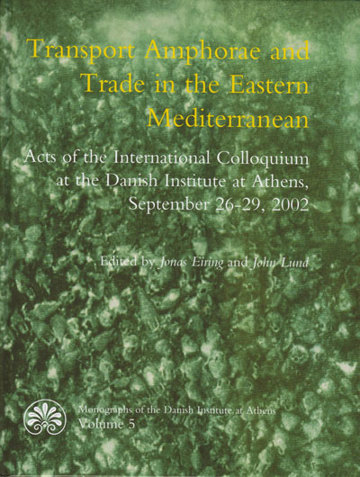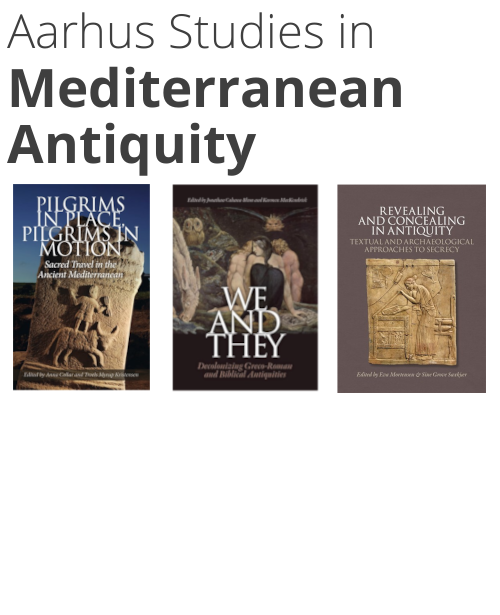
Transport Amphorae and Trade in the Eastern Mediterranean
A part of the series Monographs of the Danish Institute at Athens (5) , and the subject area Classical studies
Out of stock
Edited by
Jonas Eiring and
John Lund
With contributions by
Catherine Abadie-Reynal,
Stavroula Apostolakou,
Donald T. Ariel,
Catherine Aubert,
Rita Auriemma,
Nathan Badoud,
Pascale Ballet,
Craig Barker,
Tamás Bezeczky,
Francine Blondé,
Niculae Conovici,
Stella Demesticha,
Delphine Dixneuf,
Ersin Doger,
Jonas Eiring,
Hasan N. Erten,
Gérald Finkielsztejn,
Yvon Garlan,
Kristian Göransson,
Kristina Winther Jacobsen,
Gerhard Jöhrens,
Chrysa Karadima,
Carolyn G. Koehler,
Tatiana N. Kokorzhitskaia,
Carsten U. Larsen,
Mark L. Lawall,
John R. Leonard,
Georgij Lomtadze,
John Lund,
Vasilica Lungu,
Grzegorz Majcherek,
Daniele Malfitana,
Sandrine Marquié,
Stefanie Martin-Kilcher,
Philippa M. Wallace Matheson,
Jørgen Mejer,
Henryk Meyza,
Svetlana A. Naumenko,
Vinnie Nørskov,
Andrei Opait,
Karolina Paczynska,
Ewdoksia Papuci-Wladyka,
Elena Quiri,
Kaare Lund Rasmussen,
Nicholas K. Rauh,
Dalit Regev,
Ahmet Kaan Senol,
Gonca Cankardas Senol,
Kathleen Warner Slane,
Vivien G. Swan,
Dominique Kassab Tezgör,
Jane Timby,
Roberta Tomber,
Isik R. Türkmen,
Anna de Vincenz,
Sergey Yu. Vnukov,
Natalia Vogeikoff-Brogan,
Malcolm Wallace,
Elizabeth Lyding Will,
David F. Williams,
Samuel R. Wolff,
Abdullah Zararsiz and
Denis Zhuravlev
More about the book
About the book
As Peacock and Williams have noted, amphorae provide us "not with an index of the transportation of goods, but with direct witness of the movement of certain foodstuffs which were of considerable economic importance ... It is hard to conceive of any archaeological material better suited to further our understanding of Roman trade."
The same could be said with equal conviction about Hellenistic trade.
However, while the study of transport amphorae was already an established discipline in the 19th century, it has traditionally focused on amphora stamps. Even in the 1970s, excavators in the eastern Mediterranean were still disregarding - and even discarding - unstamped fragments.
Yet if amphora studies remain somewhat in the realm of epigraphy, they have also seen a great deal of activity in the last decade and drawn increasing attention from archaeologists, historians and other researchers. The present volume attests to this renewed interest, with more than 40 contributions, primarily in English, describing current researches and indicating which avenues of future investigation will likely prove most fruitful.
Table of contents
Excerpt
Press reviews
Kai Ruffing Sehepunkte
"Insgesamt stellt der Sammelband einen Referenzpunkt für jeder dar, der sich mit Fragestellungen beschäftigt, für die der Amphoren-Befund gewinnbringend zu nutzen ist."
The Medieval Review
"This well-edited collections of papers is probably one of the last in which such a wide geographical and chronological range of transport amphorae will be covered."
Joann Freed Wilfred Laurier University, Journal of Roman Archaeology
"The great virtues of this book are that it provides an overview, as of 2002, of the important issues in regard to amphoras in the E Mediterranean, illustrates the wide range of approaches being used, and allows the identification of leading-edge research. Furthermore, it does all this in languages accessibile to westerners...The editors provide an intelligent review af the accomplishments of the conference as well as the characteristics of amphora studies in the E Mediterranean."
Stephan G. Schmid University of Montpellier, American Journal of Archaeology
"...truly impressive...46 papers with an introduction and concluding remarks are presented in a high-quality publication...Much more than just another volume of conference acts, the book is an important landmark about the actual knowledge and future trends in amphora studies."




